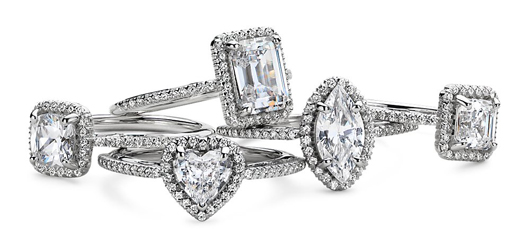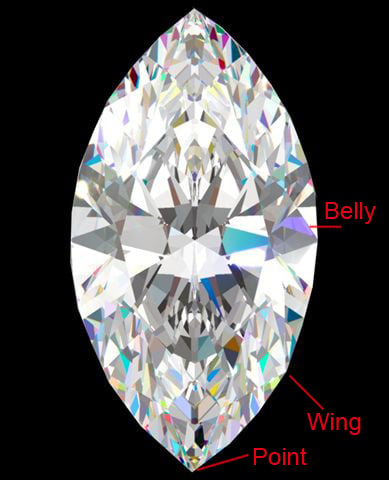
Fancy Shape Diamond Engagement Rings – blue nile
From the graceful, feminine curve of the Pear shape to the clean crisp lines of an Emerald cut, Fancy Shapes provide a diverse departure from the traditional Round Brilliant, which is the most popular diamond shape. (Visit Pricescope’s Most Popular Diamond Searches to see how different shapes rank in popularity.) Shape is personal, so there is a great deal of subjectivity in defining the beauty of Fancy cuts. The proportions for Fancies are as unique as the individual who chooses to wear them, and there are a myriad of combinations that can make for beautiful cuts. Few fancy cuts can be judged by numbers, but there are several rejection tools to use to help narrow down the vast selection in the marketplace. Accredited Gem Appraisers offers helpful cut guidelines for some fancy shapes. The AGS diamond grading lab offers cut grades for Princess cuts. AGS is also offering cut grades on Emerald and Oval cuts, but few stones are readily available.
Fancy Diamond Shapes in this Tutorial
There are many Fancy Shapes to choose from, and we are going to focus on several popular cuts, but be aware that there are multitudes of proprietary cuts available. The world of Fancy Cut diamonds is incredibly diverse, as cutters are on the pulse of innovation.
Online Buying Tools
ASET and Ideal-Scope
The ASET and the Holloway Ideal-Scope are beneficial tools used by both vendors and consumers for buying Fancy Shapes. When placed over a diamond they allow a viewer to see where light is returning to the eye and where it is escaping or leaking. Most Fancy shapes do not return light with the same efficiency of Round Brilliants, but with the help of these tools we can better understand their potential for light return under different light sources. The ASET reveals more detail, making it preferable for fancy shapes.
AGA Guidelines
Accredited Gem Appraisers (AGA) has a series of cut guides for several fancy shapes. These guides can provide general parameters in the absence of ASET? and Ideal-Scope.
http://www.gemappraisers.com
Buying in Person
When buying Fancy shapes in person, it is important to view the diamond in a variety of lighting environments. Most jewelry store lighting emphasizes a diamond’s brilliance, fire, and scintillation, so it is important to view Fancy shapes in alternative lighting. Try to view the diamond in shaded sunlight, fluorescent, (office type of lighting) and halogen or bulb type of lighting. The ASET tool is also beneficial when viewing stones in person, and the AGA guides can help narrow down selections.
Basic Terms for Fancy Shapes
Bow Tie?A darkened area that runs across the center width of elongated brilliant cuts, resembling a bow tie. Bow ties are relatively common in excessively deep or very shallow diamonds. Ovals, Marquises, Hearts, and Pear cuts will often show bow ties of varying degrees. A bow tie will become more obvious when the difference between the stone?s length to width extends, and pavilion angle variations increase. Bow ties show as light return that is blocked by the head of the viewer?aka head obstruction. Think of it as light return going in the wrong direction. As the head obstructs the light supply, the viewer sees a darkened area running across the width of the elongated shape.

Whiteflash photo posted by Colored Gemstone Nut
Brilliant Cut – Type of cut that features kite and triangular shaped facets. Examples?Oval Cut and Cushion Cut
Mixed Cut – Type of cut that features both brilliant and step cut faceting. Example Radiant Cut and Princess Cut
Step Cut – Type of cut with straight facets on the crown and pavilion that run parallel to the girdle. Examples?Emerald Cut and Asscher Cut
Length to Width Ratio Compares the relationship between the length and width of Fancy Shapes by numerically illustrating how long or wide the stone appears from the face up view.
Length ÷ Width
Example An oval diamond has a length of 9mm and a width of 6mm 9 ÷ 6 = 1.50:1
Spread Factor
The spread of a faceted diamond indicates how large or small the stone appears from the face up view. Factors that affect spread are total depth percentage, girdle thickness, crown angle, and pavilion angle or, in the case of fancies, angles. Shallower stones generally have greater spread while deeper stones have less spread. But fancies have more angles so the ratio of depth to spread can vary according to design. For this reason fancies should be judged on a stone by stone basis.
When searching for diamonds from the PriceScope homepage, you can select to search for In-House stones, and you can see the comparative spread factor among Fancy Shapes. Here is a selection of current Princess cuts. The spread factors are listed per stone. This compares the listed diamonds face up or surface area to that of a Tolkowsky round diamond. For example a 1.00ct round has a 6.47mm diameter or 32.88 square millimeters.
https://www.pricescope.com/diamond-search-results/? Click on the link and choose princess as your shape, and you should see the spread factor, as shown below.

A negative value indicates a smaller spread and a positive value indicates that the stone will face up larger for its relative carat weight. Another factor is light return at the edges of the diamond. For example, most princess cuts with the same spread as a round diamond may still appear smaller because they often have weaker light return near the edges.
Basic Parts for Fancy Shapes



Next Diamond Tutorial: Princess Cut Diamond
Discuss Diamonds in the Pricescope Forum

















